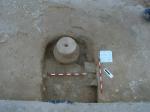Summary (English)
Research (09/1999-02/2000)
In this archaeological intervention, a 160 m2 rectangular area was located on the western side of a wall that we supposed determined the eastern limit of the Forum’s southern area. This public space, according to the working hypotheses, had to be implanted in central position. It would be accessed by a door on the western side, connected with a wide street that would converge perpendicularly with Popilio Street.
The choice of this place for developing our work was specifically due to the attempt to confirm the hypotheses that a portico would have delimited the square on its eastern side. We also intended to find the probable access door that would be axially facing the one already known (Olcina and Pérez, 1998: 76-77).
The results of the excavation in this area can be summarized in the following: – The existence of an arcaded corridor delimited by the eastern closing wall and a 7-column row from the western access door is confirmed. The part of this this door that we located, next to the northern limit of the excavation, was the hole for the hinge of the southern shutter. Four attic column bases were recovered (Fig.2): 3 with equal torus and a narrow scotia (although two of them were highly deteriorated), and the remainder had different toruses and the widest scotia. – The forum, or at least the excavated part, dates between the years 30 and 20 BC. This dating derives from the numerous materials that formed the levelling fill of the floor in the portico. – The forum’s construction destroyed a large former building whose main element is a strong wall parallel to the eastern closing of the excavated porch. Everything suggests that it is a large public building that determined, to a certain extent, the configuration of the later complex.
The ruin of the forum has been documented since the middle of the 2nd century AD. First of all, the pavement –most probably a stone one– of the portico was dismantled. Finally, around the middle of the 3rd century AD, the robbing of the last elements of construction of some importance took place. It even affected the foundations of the portico columns. This evidence corroborates the early decline of this Roman town.
(translation by David Guerra Díaz)
Director
- Manuel Olcina Doménech
- Rafael Pérez Jiménez
Team
- Daniel Ortega Azuar, Daniel Belmonte Mas, Francisco Javier Moltó Poveda, Inmaculada Quiles Calero, Eva Tendero Porras
- María Sellés Nogueroles
- MARQ, Museo Arqueológico Provincial de Alicante
Research Body
- Colegio Oficial de Doctores y Licenciados en Filosofía y Letras y en Ciencias de Alicante - Sección de Arqueología
Funding Body
- Consejería de Empleo y la Diputación de Alicante






![Download [PDF]](/excavation/skins/fasti/images/results/download_sml.png)